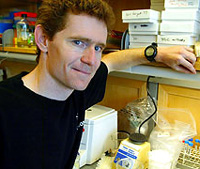By
Wallace Ravven
UCSF scientists have identified two suspects in the massive die-off of half a million bee colonies in the US. Joe DeRisi, PhD, and Don Ganem, MD, both Howard Hughes Medical Institute investigators at UCSF, have used a powerful combination of a "virus chip" - a microarray with DNA samples of most known viruses and fungi - and "shotgun" sequencing, which identifies telltale DNA from random samples of the biological sample.
The Army's Edgewood Chemical Biological Center at the Aberdeen Proving Ground in Maryland sent DeRisi samples to analyze from bees in the Central Valley of California. DeRisi and Ganem identified a parasite known to have caused massive bee losses in the last decade, making it a candidate as a culprit responsible for bee collapse in the US. The parasite is called
Nosema ceranae, a so-called microsporidian fungus - a small, single-celled parasite that mainly has been associated with affecting Asian bees, and is thought to have jumped to the Western honeybee in the last few years. The shotgun approach succeeded in this search, as the microarry does not include this species' DNA.
 |
Joe DeRisi |
The lab's search for culprits using the micorarray, however, also netted a second potential killer, a virus from the genus Iflavirus, which has been implicated in a number of problems in the bee industry.
"The next - and very critical - step is to assay other failing hives around the country and the world to measure to what degree these pathogens we have identified are also associated with bee collapse elsewhere," DeRisi said. "We can't say that because the bees in Central Valley may have fallen to one or both of these pathogens that we have now proven that this is the cause throughout the United States."
 |
Don Ganem |
The virus chip gene-hunting technique is designed to identify a sample virus by comparing its DNA or RNA to more than 20,000 snippets of genetic material derived from all known viruses found in humans, animals, plants, fungi and bacteria. The microarry also has gene sequences from other microorganisms. The chip draws on computer chip technology, computation and bioinformatics, but in essence it is a simple 3 x 1 inch glass microscope slide. Onto the slide the scientists robotically deposit 10 to 12 different DNA sequences from all the viruses. Each sample appears as a microscopic dot, about a tenth of a millimeter in diameter - giving it the name micoroarray. Researchers then wash fluorescently tagged DNA from a sample of interest over the slide, and wherever the two sets of nucleic acid match up, they anneal to each other. The slide is then rinsed and visualized with a scanning laser microscope. The dots that have found a match glow with fluorescent light.
During the SARS scare in 2003, the Centers for Disease Control and Prevention (CDC) turned to DeRisi for help in identifying the cause of SARS, or severe acute respiratory syndrome. His lab used the virus chip to confirm the culprit, a new form of coronavirus. Last year DeRisi and Ganem, in collaboration with scientists at the Cleveland Clinic, discovered a previously unknown human virus associated with prostate cancer.
DeRisi is professor of biochemistry, and Ganem is professor of microbiology and immunology at UCSF.
(Photo licensed from Benjamin Harrison)
Related Links:
UCSF Scientist Tracks Down Suspect in Honeybee Deaths
San Francisco Chronicle, April 26, 2007
Experts May Have Found What's Bugging the Bees
Los Angeles Times, April 26, 2007
Bees Vanish, and Scientists Race for Reasons
New York Times, April 23, 2007
UCSF's DeRisi and Ganem Cited as "Modern-Day Virus Hunters"
UCSF Today, August 22, 2006
Virus Chip Detects New Virus in Prostate Tumors
UCSF News Release, February 24, 2006
SARS Stars
UCSF Magazine, May 2003
Nosema ceranae
Wikipedia
DeRisi Lab
Ganem Lab

